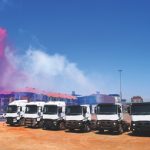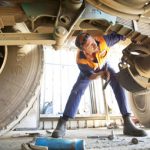Spirit of adventure

Icebergs, searing heat, dead-calm waters and tropical storms are just some of the challenges contestants in the 38 739 nautical-mile Volvo Ocean Race have to tackle. GAVIN MYERS and JACO DE KLERK traded their trucking caps for life jackets to follow the action.
The human spirit is an interesting thing. It pushes us to push ourselves. It pushes us to be the best; to set out on crazy, dangerous and wonderful adventures – and survive them. Not for money, perhaps for glory, but mainly to prove that it can be done.
The Volvo Group, known for its hallmark of safety and quality, is not an organisation one might associate with such a whimsical attitude, but scratch a little deeper and you’ll find that the ties that bind go quite deep. The spirit of Volvo constantly pushes design, innovation, technology, strength, endurance and teamwork – all the cornerstones that comprise the spirit of the Volvo Ocean Race.
This race began in 1973, originally as the Whitbread Round the World Race. Volvo has been the title sponsor since 2001. The race is actually 50 percent owned by Volvo Group and 50 percent owned by Volvo Cars. Of course, a lot changes in 40 years and, although three lives were lost in that very first race, it was a lot more luxury sailing and a lot less of a professional sport.
This year saw entries from seven teams, including the first all-women’s team in ten years. The women’s team is allowed 11 sailors, while men’s teams are allowed only eight. This is to help level the playing field in what is an extremely physical event.
The teams stock only freeze-dried food and, although they eat around 6 000 calories a day, they lose about ten kilograms on each leg of the race! The team members are supposed to sail in four-hour shifts, but, even so, sleeping is difficult.
 This 12th edition of the race is also the first in which all the boats are identical. Known as the Volvo Ocean 65, the highly advanced boats were designed to cut costs in half. Like Volvo’s vehicles they are of exceptional quality (they will last for two races) and offer improved safety and stability. A one-make race has the added benefit of putting focus on the individuals, rather than who can afford the most advanced vessel.
This 12th edition of the race is also the first in which all the boats are identical. Known as the Volvo Ocean 65, the highly advanced boats were designed to cut costs in half. Like Volvo’s vehicles they are of exceptional quality (they will last for two races) and offer improved safety and stability. A one-make race has the added benefit of putting focus on the individuals, rather than who can afford the most advanced vessel.
This was clearly evident as the boats began to pull into Cape Town at the end of the first leg on Wednesday, November 12; the race beginning in Alicante, Spain. Team Abu Dhabi finished first, with team Dongfeng arriving just ten minutes later! Teams SCA and Mapfre brought up the rear two days later …
In addition to the sights and sounds of the race village, a highlight of each stop is the in-port race. Held on Saturday, November 15, countless boats gathered in the bay to watch the teams attack the three-lap course. In the end it was teams Abu Dhabi, Brunel and SCA that took the top three spots of what was a very tight race. Points from the in-port races only count in splitting ties at the end of the event.
Oh, there is also no prize money – the winners get to hoist the trophy and boast that they had the spirit to conquer one of the world’s most extreme sporting challenges!
By the time you read this, the teams will be well on their way to arriving in their next port – Abu Dhabi. Happily, each boat is fitted with five cameras and also carries a dedicated media representative, so you can watch the action live on the volvooceanrace.com website. You can also download the Volvo Ocean Race app to follow the action on your mobile devices.
Do it – you’ll be amazed at what the human spirit can achieve.
(The eastern) wind of change
A truck manufacturer sponsoring a yacht in the Volvo Ocean Race? It makes perfect sense. But Dongfeng isn’t, exactly, the first that would come to mind … One of China’s leading truck brands, Dongfeng Trucks (with Dongfeng adequately meaning “the eastern wind”), is sponsoring the Dongfeng Race Team, in what is called the Everest of sailing.
The company wants to utilise the Volvo Ocean Race’s international platform to develop its overseas market. “The first thing is to promote our brand, so that people can know who we are – by means of this race, we can utilise the media resources to promote awareness to the overseas markets,” says Liu Licheng, vice president of the manufacturing technology and overseas business departments at Dongfeng Trucks. “We want to shift Dongfeng Trucks from a Chinese brand to a global brand.”
 In Cape Town, the Dongfeng pavillion was abuzz with constant activity – from Kung Fu warriors to interactive media via tablets, movies and the ever-friendly Dongfeng staff, and on the sea the company had another yacht – dubbed the Extreme 40 – to give guests a glimpse of what it takes to sail a yacht and to highlight the excitement.
In Cape Town, the Dongfeng pavillion was abuzz with constant activity – from Kung Fu warriors to interactive media via tablets, movies and the ever-friendly Dongfeng staff, and on the sea the company had another yacht – dubbed the Extreme 40 – to give guests a glimpse of what it takes to sail a yacht and to highlight the excitement.
“The team has traversed the first leg and encountered some problems, but they’ve pushed through,” Licheng tells FOCUS. “Just like our Dongfeng trucks during our plans to expand into the overseas market.”
The company wants to first focus its attention on developing markets, before setting its sights on Europe. “We want to go global step by step. When we are mature enough, we will try to enter into the European market,” says Licheng.
The company isn’t going to just offer what it thinks these markets might want, however … “We have some new products to be placed in those markets, but we first want to find out more about the market demand,” he says. “Then we can decide which products we should place there and what kind of service network we should offer.”
South Africa is high on Dongfeng’s list. “In 2015 we will set up a new after-sales and service network. Through these we will distribute throughout South Africa and into the whole of Africa.” Licheng adds that the company will provide more support to develop its market here.
Licheng eloquently summarises: “We are developing our overseas markets, which is uncharted waters for us – so we have to challenge ourselves, just like when we are facing the sea … everything is unknown, but we have to conquer the ocean and we have to conquer the markets …”
Published by
Focus on Transport
focusmagsa




